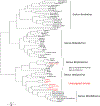Problems of classification in the family Paramyxoviridae
- PMID: 29372404
- PMCID: PMC6309968
- DOI: 10.1007/s00705-018-3720-2
Problems of classification in the family Paramyxoviridae
Abstract
A number of unassigned viruses in the family Paramyxoviridae need to be classified either as a new genus or placed into one of the seven genera currently recognized in this family. Furthermore, numerous new paramyxoviruses continue to be discovered. However, attempts at classification have highlighted the difficulties that arise by applying historic criteria or criteria based on sequence alone to the classification of the viruses in this family. While the recent taxonomic change that elevated the previous subfamily Pneumovirinae into a separate family Pneumoviridae is readily justified on the basis of RNA dependent -RNA polymerase (RdRp or L protein) sequence motifs, using RdRp sequence comparisons for assignment to lower level taxa raises problems that would require an overhaul of the current criteria for assignment into genera in the family Paramyxoviridae. Arbitrary cut off points to delineate genera and species would have to be set if classification was based on the amino acid sequence of the RdRp alone or on pairwise analysis of sequence complementarity (PASC) of all open reading frames (ORFs). While these cut-offs cannot be made consistent with the current classification in this family, resorting to genus-level demarcation criteria with additional input from the biological context may afford a way forward. Such criteria would reflect the increasingly dynamic nature of virus taxonomy even if it would require a complete revision of the current classification.
Conflict of interest statement
Figures


References
-
- Brown DD, Collins FM, Duprex WP, Baron MD, Barrett T, Rima BK (2005) “Rescue” of mini-genomic constructs and viruses by combinations of morbillivirus N, P and L proteins. J Gen Virol 2005(86):1077–1081 - PubMed
-
- Jones DT, Taylor WR, Thornton JM (1992) The rapid generation of mutation data matrices from protein sequences. Comput Appl Biosci 8:275–282 - PubMed
MeSH terms
Substances
Grants and funding
LinkOut - more resources
Full Text Sources
Other Literature Sources
Research Materials

